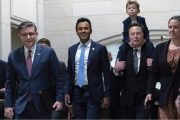
A research paper published on September 7 in Personality and Social Psychology Bulletin (PSPB) — an official journal for the Society of Personality and Social Psychology — said that “millennials” (which the researchers defined as young adults born between 1980 and 1994) are currently more politically polarized than Generation Xers and Baby Boomers. The paper said they are also more likely to identify as “conservative” than members of the Generation X or Baby Boomer generations were at the same age.
Jean Twenge, professor of psychology at San Diego State University, was the lead author of the paper entitled “More Polarized but More Independent: Political Party Identification and Ideological Self-Categorization Among U.S. Adults, College Students, and Late Adolescents, 1970-2015.” Twenge told CNN:
High school seniors are more likely to identify as political conservatives now compared to 10 years ago. Most surprising, more identify as conservatives now compared to the 1980s, presumably the era of the young conservative, such as the character Alex P. Keaton in the 1980s show “Family Ties.” That goes against the common view of millennials as very liberal.
So the current view of millennials as liberals might be due to their age — young people are more likely to be liberal. But if you compare young people now to young people in previous decades, those now are more conservative.
CNN reported that the paper reviewed data on about 10 million American adults, collected from 1970 to 2015 as part of three separate surveys: the national Monitoring the Future study, the Higher Education Research Institute’s American Freshman survey, and the General Social Survey.
Millennials were not the only demographic studied for the paper, but their participation did impact the overall findings. On the matter of polarization, for example, the researchers noted that, overall, twice as many adults had “extreme” political identifications in the 2010s compared to in the 1970s.
For example, while only 1.6 percent of all Americans identified as “extremely liberal” in 1972, 3.7 percent did so in 2014. Only 2.4 percent of Americans identified as “extremely conservative” in 1972, but this self-identification increased to 4.2 percent in 2014, the new study found.
Ryne Sherman, associate professor of psychology at Florida Atlantic University and a co-author of the study, told CNN: “We were not really sure what to expect because [separate] research looking at Americans’ responses to specific issues — such as government spending, taxes, military — consistently shows that Americans are not polarized on the vast majority of the issues.”
Sherman went on to note that while Americans are not that polarized on certain issues, they are polarized when it comes to how they identify themselves politically.
“However, our research does show increasing polarization in terms of political identification” Sherman said. “This is intriguing because it suggests that Americans are becoming increasingly divided over a relatively small number of differences.”
A statement by Twenge attempting to explain the apparent disconnect between millennials’ views on specific issues and how they identified themselves politically suggested that their definition of “conservative” may not be the same as many older Americans’ use of the term. Twenge said:
We know from other research that millennials are more supportive of LGBT rights, gender equality and racial equality compared to previous generations. Given that, it suggests that millennial conservatives may be focusing on issues other than these, for example, economic issues, gun rights.
The data published in the new paper indicated that as millennials headed into college, 23 percent of them identified as far-right, compared with 17 percent for Baby Boomers and 22 percent of Gen Xers, according to CNN.
The reason for some inconsistencies in the way that millennials identify themselves (such as a person describing themselves as “far right,” while being supportive of “LGBT rights”) may be a reflection of poorly defined terms used to describe political positions that prevail among people of all generations. The term “conservative,” for example, means something far different to most people today than it did when it was used to describe Ohio Senator Robert A. Taft back in the 1940s and early 1950s. Taft was a leading advocate of non-interventionism in foreign policy, yet many of his successors in the Republican Party (John McCain is a leading example) are very much interventionists. Such individuals are not traditional conservative in the mold of Taft, but a new breed in the political spectrum — neoconservatives, or neocons.
Modern advocates of a noninterventionist foreign policy, such as former Representative Ron Paul (R-Texas) are more accurately described as constitutionalists, rather than conservatives. However, the term “constitutionalist” was not even part of this latest research paper.
Some libertarians, such as Libertarian Party presidential candidate Gary Johnson, may be conservative on economic issues and as liberal as many of the polled millennials were on social issues, but the description “libertarian” was not used in the study, either. Moreover, other libertarians, such as Paul, tend to be conservative on moral and family issues.
Therefore, the “big news” offered by this paper, that millennials are more conservative than the two preceding generations, must be viewed with a degree of skepticism. It is quite possible that the typical millennial has not received sufficient education in political philosophy to make an accurate self-assessment of himself or herself.
An article (“Conservatism is Dead; Long Live Conservatism?”) published in The American Thinker back in 2008 discussed some of the problems in determining the direction of American politics. Was it tilting toward the right, or to the left? As the author noted:
The definition of “conservative” is fluid, changing from time to time and place to place. Some “conservatives” embrace an ideology prescribing limited government — one remaining within the boundaries established by the Constitution — and low taxation. They favor nationalism over internationalism; prefer markets mostly unfettered by regulation; eschew multiculturalism, feminism and radical environmentalism; and take pride in our history and traditions.
The article included a very perceptive quote from that philosophical genius, G.K. Chesterton: “The whole modern world has divided itself into Conservatives and Progressives. The business of Progressives is to go on making mistakes. The business of the Conservatives is to prevent the mistakes from being corrected.”
The writer made this observation about how conservatives and liberals differ:
Both liberals and conservatives have shape-shifting visions. This is because the definitions of conservative and liberal are determined by the “position” of the given society’s political spectrum. Shift that spectrum left or right by altering the collective ideology of a nation, and the definitions of those two words will change commensurate with the degree of that shift.
Since today’s political spectrum is much more liberal than the specturm of two or three decades ago, a millennial’s idea of “conservative” is probably also much further to the left than a Baby Boomer’s definitiion.
A hopeful conclusion to be drawn from the new paper is that millennials realize that much is wrong with today’s society. Since many of them are just entering the job market, it is evident to them that our economy is far from healthy. So they are open to things that might improve things economically, such as a free market. This is why many consider themselves to be “conservative.” However, never having lived in a society governed by traditional moral values, they cannot as easily appreciate connection between traditional morality and freedom.
If there is an optimistic nugget to be found all of this, it is that millennials are still a “work in progress,” and tend to possess the open-mindedness that is natural to young people. Constitutionalists and moral conservatives can capitalize on those traits to help mentor these millennials and have a positive impact on their development.
Related articles:



